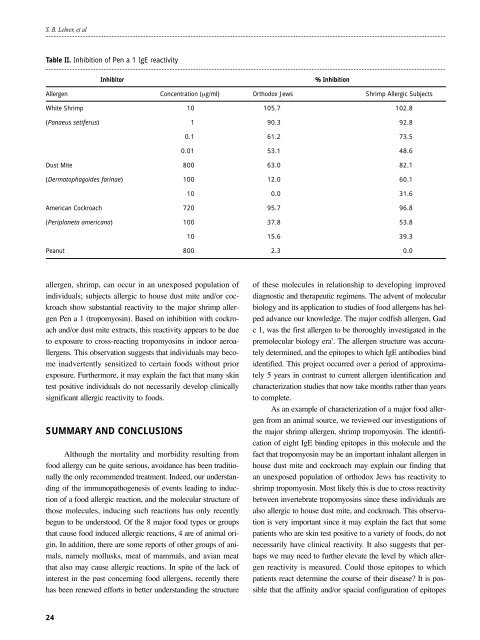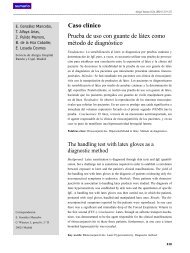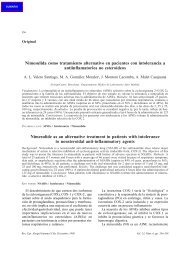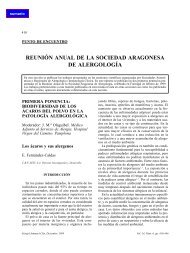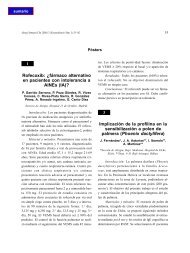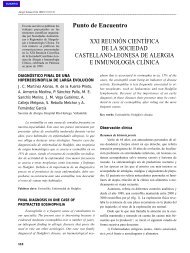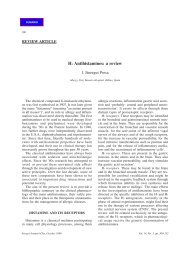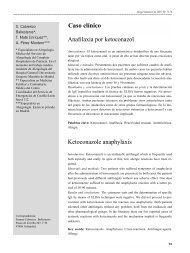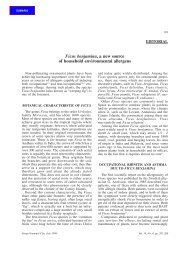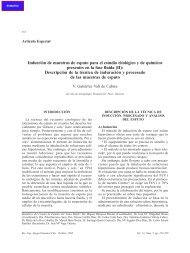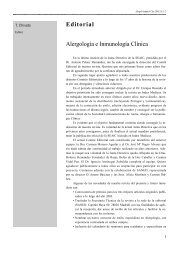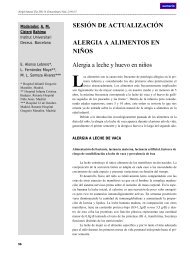Aplicación de la biología molecular en alergia a alimentos
Aplicación de la biología molecular en alergia a alimentos
Aplicación de la biología molecular en alergia a alimentos
You also want an ePaper? Increase the reach of your titles
YUMPU automatically turns print PDFs into web optimized ePapers that Google loves.
S. B. Lehrer, et al<br />
Table II. Inhibition of P<strong>en</strong> a 1 IgE reactivity<br />
allerg<strong>en</strong>, shrimp, can occur in an unexposed popu<strong>la</strong>tion of<br />
individuals; subjects allergic to house dust mite and/or cockroach<br />
show substantial reactivity to the major shrimp allerg<strong>en</strong><br />
P<strong>en</strong> a 1 (tropomyosin). Based on inhibition with cockroach<br />
and/or dust mite extracts, this reactivity appears to be due<br />
to exposure to cross-reacting tropomyosins in indoor aeroallerg<strong>en</strong>s.<br />
This observation suggests that individuals may become<br />
inadvert<strong>en</strong>tly s<strong>en</strong>sitized to certain foods without prior<br />
exposure. Furthermore, it may exp<strong>la</strong>in the fact that many skin<br />
test positive individuals do not necessarily <strong>de</strong>velop clinically<br />
significant allergic reactivity to foods.<br />
SUMMARY AND CONCLUSIONS<br />
Although the mortality and morbidity resulting from<br />
food allergy can be quite serious, avoidance has be<strong>en</strong> traditionally<br />
the only recomm<strong>en</strong><strong>de</strong>d treatm<strong>en</strong>t. In<strong>de</strong>ed, our un<strong>de</strong>rstanding<br />
of the immunopathog<strong>en</strong>esis of ev<strong>en</strong>ts leading to induction<br />
of a food allergic reaction, and the molecu<strong>la</strong>r structure of<br />
those molecules, inducing such reactions has only rec<strong>en</strong>tly<br />
begun to be un<strong>de</strong>rstood. Of the 8 major food types or groups<br />
that cause food induced allergic reactions, 4 are of animal origin.<br />
In addition, there are some reports of other groups of animals,<br />
namely mollusks, meat of mammals, and avian meat<br />
that also may cause allergic reactions. In spite of the <strong>la</strong>ck of<br />
interest in the past concerning food allerg<strong>en</strong>s, rec<strong>en</strong>tly there<br />
has be<strong>en</strong> r<strong>en</strong>ewed efforts in better un<strong>de</strong>rstanding the structure<br />
24<br />
Inhibitor % Inhibition<br />
Allerg<strong>en</strong> Conc<strong>en</strong>tration (µg/ml) Orthodox Jews Shrimp Allergic Subjects<br />
White Shrimp 10 105.7 102.8<br />
(Panaeus setiferus) 1 90.3 92.8<br />
0.1 61.2 73.5<br />
0.01 53.1 48.6<br />
Dust Mite 800 63.0 82.1<br />
(Dermatophagoi<strong>de</strong>s farinae) 100 12.0 60.1<br />
10 0.0 31.6<br />
American Cockroach 720 95.7 96.8<br />
(Perip<strong>la</strong>neta americana) 100 37.8 53.8<br />
10 15.6 39.3<br />
Peanut 800 2.3 0.0<br />
of these molecules in re<strong>la</strong>tionship to <strong>de</strong>veloping improved<br />
diagnostic and therapeutic regim<strong>en</strong>s. The adv<strong>en</strong>t of molecu<strong>la</strong>r<br />
biology and its application to studies of food allerg<strong>en</strong>s has helped<br />
advance our knowledge. The major codfish allerg<strong>en</strong>, Gad<br />
c 1, was the first allerg<strong>en</strong> to be thoroughly investigated in the<br />
premolecu<strong>la</strong>r biology era 7 . The allerg<strong>en</strong> structure was accurately<br />
<strong>de</strong>termined, and the epitopes to which IgE antibodies bind<br />
i<strong>de</strong>ntified. This project occurred over a period of approximately<br />
5 years in contrast to curr<strong>en</strong>t allerg<strong>en</strong> i<strong>de</strong>ntification and<br />
characterization studies that now take months rather than years<br />
to complete.<br />
As an example of characterization of a major food allerg<strong>en</strong><br />
from an animal source, we reviewed our investigations of<br />
the major shrimp allerg<strong>en</strong>, shrimp tropomyosin. The i<strong>de</strong>ntification<br />
of eight IgE binding epitopes in this molecule and the<br />
fact that tropomyosin may be an important inha<strong>la</strong>nt allerg<strong>en</strong> in<br />
house dust mite and cockroach may exp<strong>la</strong>in our finding that<br />
an unexposed popu<strong>la</strong>tion of orthodox Jews has reactivity to<br />
shrimp tropomyosin. Most likely this is due to cross reactivity<br />
betwe<strong>en</strong> invertebrate tropomyosins since these individuals are<br />
also allergic to house dust mite, and cockroach. This observation<br />
is very important since it may exp<strong>la</strong>in the fact that some<br />
pati<strong>en</strong>ts who are skin test positive to a variety of foods, do not<br />
necessarily have clinical reactivity. It also suggests that perhaps<br />
we may need to further elevate the level by which allerg<strong>en</strong><br />
reactivity is measured. Could those epitopes to which<br />
pati<strong>en</strong>ts react <strong>de</strong>termine the course of their disease? It is possible<br />
that the affinity and/or spacial configuration of epitopes


